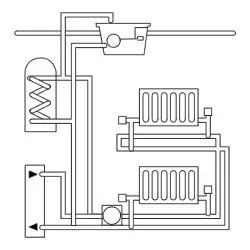Pumped Systems
These are by far the most common type of central heating system though the sealed system is becoming more and more popular. The water is heated by the boiler and sent round the pipework by means of a pump. The water is then routed to the radiator circuit and / or the hot water cylinder by means of a motorised valve.

Gravity Systems
The gravity system is pretty reliable as it doesn’t have a pump. It does however need larger 28mm pipes. For best results, the cylinder is installed upstairs above the boiler.
The same water recirculates round the system. There is a ‘feed and expansion’ cistern (usually in the loft) which keeps the system topped up when water is lost by evaporation or leakage. This same cistern is also used to cope with expansion of water from the system as it heats up.
Above the cistern you’ll see a pipe which hangs over it. This is called the vent pipe and acts as a safety measure so that excess pressure can be relieved.
Sealed system
In older properties, gravity circulation is used to heat the hot water cylinder. This works on the principal that water expands when heated. The result is that it actually weighs less than cold water. This phenomenon is very handy as the cold heavier water sinks to the bottom of the system and causes the hot water to be pushed up.
These types of central heating systems are gaining in popularity now for a number of reasons. As the name implies, the system is closed and has no feed and expansion cistern. It is most common for the boiler to be a combination type rather than connected individual components. These are very efficient and have the added advantage of saving space.
A pressure vessel copes with expansion and contraction of the water. In addition there is a safety valve to relieve excess pressure instead of a vent pipe.
On the upside, these systems run at a generally higher temperature than other types and therefore radiators can be a little smaller. These systems suffer less from corrosion. The other major advantage is that not only is less pipework needed, but also no space is required in the loft for a feed and expansion cistern.
On the downside, because the system runs under pressure, the installation requires higher quality fittings to ensure leaks do not occur. Also, since the system is not automatically topped up, in addition to the thermostat, the boiler must have a safety cut out to prevent over heating in the event of water loss.
You should also consider guarding against the very hot radiators, particularly if you have young children.
Controls
Various controls are incorporated into heating systems.
The programmer turns the boiler on and off automatically according to the settings you give it. These may be very simple affairs or may be more elaborate with the ability to have different time settings for weekdays and weekends.
Thermostats switch the pump on and off or open a motorised valve according to the temperature of the surroundings.
Thermostatic radiator valves are used to switch the flow on and off to individual radiators.
Energy managers can be fitted to control the operation of a boiler to minimise energy waste. Instead of allowing a boiler to be turned on and off frequently as water temperatures fluctuate slightly, these devices override the system and manage energy use efficiently.
Hot water
The hot water supply is, in the case of a conventional boiler, heated by a pipe which runs from the boiler, coils through the hot water cylinder, and returns to the boiler. The water in the cylinder is completely separate from that which goes through the boiler.
The temperature of the hot water is controlled by a cylinder thermostat which switches the pump on and off or opens a motorised valve.
In the case of combination boilers, mains water is heated on demand as it is drawn. Again, the two lots of water are separate from each other.
